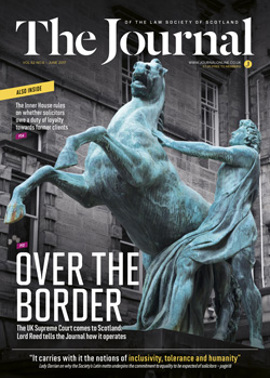Secondary victims in clinical negligence
“What is required in order to found liability is something which is exceptional in nature” (Liverpool Women’s Hospital NHS Foundation Trust v Ronayne [2015] EWCA Civ 588). This quote nicely summarises the difficulty met when advancing secondary victim claims. The most recent Scottish case of Young v MacVean [2015] CSIH 70, only served to demonstrate that the control mechanism set down by Alcock v Chief Constable of South Yorkshire [1992] 1 AC 310, has set the bar very high. Until proved otherwise, the assumption is that a secondary victim will not recover damages. Young v MacVean also confirmed that a psychiatric injury as a result of being told about a death will not succeed. The injury must be caused by what the pursuer directly perceives, through his or her own unaided senses.
RE (a minor) v Calderdale & Huddersfield NHS Foundation Trust [2017] EWHC 824 (QB) is an English High Court judgment which may be of assistance to practitioners in clinical negligence cases where secondary victim claims are to be advanced. This case is worthy of note because claims were pursued by both the mother as primary victim and grandmother as secondary victim in a case involving birth injury to RE.
There was no dispute on the medical evidence and it was accepted that both the mother and grandmother had suffered post-traumatic stress disorder as a result of witnessing the birth of RE. A claim was also advanced on behalf of RE, who suffered a hypoxic brain injury as a result of a negligent delay in her delivery.
Goss J referred to the facts that RE was born “flat and apnoeic with a purple and swollen head… the second claimant [mother], justifiably, thought she was dead... [RE’s] condition on birth was a sudden and unexpected event and not a process of gradual realisation”. There was no warning RE would be born in that state despite what had been a physically difficult labour and delivery. He held that “this was an outwardly shocking experience that was exceptional in nature and horrifying as judged by objective standards and by reference to persons of ordinary susceptibility”. Having considered the facts as they were presented to RE’s grandmother in real time, Goss J held that they were sufficiently shocking that her claim for damages for nervous shock must succeed.
Primary and secondary victims
Secondary victim claims are generally advanced where there is a marital or parental relationship between the pursuer and primary victim (Taylor v A Novo (UK) Ltd [2013] EWCA Civ 194). RE helpfully adds to the examples of what constitutes a shocking event and supports a grandparent’s claim for nervous shock. There cannot be any doubt that RE’s father, who was also in attendance for the birth, would also have been entitled to pursue a secondary victim claim.
Goss J held that RE started to sustain negligently caused damage when her head was crowned but her body remained in the birth canal. At this point RE and her mother were to be treated as one. Being in utero, RE and her mother were, in law, to be considered as a single legal entity and therefore RE’s mother was a primary victim and not merely a secondary witness to it. As a primary victim, RE’s mother was not subject to the stringent control mechanisms applied to secondary victim claims.
In practice, one of the other challenges of these claims is proving that the psychiatric condition has been caused by the particular circumstances of the birth, as opposed to a grief reaction for the loss of a healthy child. This is an issue which can only be addressed by reference to independent, psychiatric medical opinion.
The case is most interesting for its analysis of RE’s mother as a primary victim and the addition of grandparent to secondary victims. Its application is likely to be very limited; however it is another factor for practitioners to consider in birth injury cases.
In this issue
- Neutrality policies in commercial companies
- Court IT: the young lawyers' view
- Human rights: answering to the UN
- Galo and fair trial: which way for Scotland?
- Secondary victims in clinical negligence
- Reading for pleasure
- Opinion: Alan W Robertson
- Book reviews
- Profile
- President's column
- Twin tracks to completion
- People on the move
- Court of the nations
- Second time around
- How to avoid a summer tax scorcher
- Humani nihil alienum: a call to equality
- Sheriff commercial procedure: count 10
- Taking a pay cut: fair to refuse?
- Fine to park here?
- Enter the Bowen reforms
- Home grown
- Limited partnerships: a new breed
- Salvesen fallout: the latest round
- Gambling in football – the Scottish perspective
- Scottish Solicitors' Discipline Tribunal
- Changing sides
- Business drivers
- CCBE comes to Edinburgh
- "Find a solicitor" gets an upgrade
- Law reform roundup
- Thoughts on a frenetic year
- Check those bank instructions
- Fraud alert – ongoing bank frauds identified
- AML: sizing up the risk
- Master Policy Renewal: what you need to know
- Without prejudice
- What's the measure of a ruler?
- Ask Ash






